
The Beach Boys are an American rock band that formed in Hawthorne, California, in 1961. The group's original lineup consisted of brothers Brian, Dennis, and Carl Wilson, their cousin Mike Love, and friend Al Jardine. Distinguished by their vocal harmonies, adolescent-oriented themes, and musical ingenuity, they became one of the most influential acts of the rock era. They drew on the music of older pop vocal groups, 1950s rock and roll, and black R&B to create their unique sound, and under Brian's direction, often incorporated classical or jazz elements and unconventional recording techniques in innovative ways.

James Marshall "Jimi" Hendrix was an American musician, singer, and songwriter. Although his mainstream career spanned only four years, he is widely regarded as one of the most influential electric guitarists in the history of popular music, and one of the most celebrated musicians of the 20th century. The Rock and Roll Hall of Fame describes him as "arguably the greatest instrumentalist in the history of rock music".

Smiley Smile is the twelfth studio album by American rock band the Beach Boys, released on September 18, 1967. It reached number 9 on UK record charts, but sold poorly in the US, peaking at number 41—the band's lowest chart placement to that point. Critics and fans generally received the album and its lead single, "Heroes and Villains", with confusion and disappointment. "Good Vibrations" and "Gettin' Hungry" were also released as singles, but the former was issued a year earlier, while the latter was not credited to the band.

Friends is the fourteenth studio album by American rock band the Beach Boys, released on June 24, 1968, through Capitol Records. The album is characterized by its calm and peaceful atmosphere, which contrasted the prevailing music trends of the time, and for its brevity, with five of its 12 tracks running less than two minutes long. It sold poorly, peaking at number 126 on the US Billboard charts, the group's lowest US chart performance to date, although it reached number 13 in the UK. Fans generally came to regard the album as one of the band's finest.
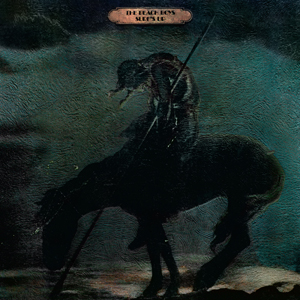
Surf's Up is the seventeenth studio album by American rock band the Beach Boys, released August 30, 1971 on Brother/Reprise. It received largely favorable reviews and reached number 29 on the US record charts, becoming their highest-charting LP of new music in the US since 1967. In the UK, Surf's Up peaked at number 15, continuing a string of top 40 records that had not abated since 1965.
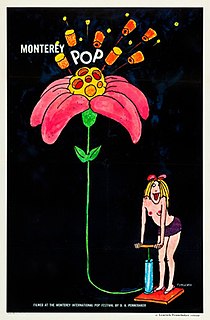
Monterey Pop is a 1968 American concert film by D. A. Pennebaker that documents the Monterey Pop Festival of 1967. Among Pennebaker's several camera operators were fellow documentarians Richard Leacock and Albert Maysles. The painter Brice Marden has an "assistant camera" credit, and Bob Neuwirth, who figured prominently in Pennebaker's Bob Dylan documentary Dont Look Back, acted as stage manager. Titles for the film were by the illustrator Tomi Ungerer. Featured performers include Big Brother and the Holding Company with Janis Joplin, Jefferson Airplane, Hugh Masekela, Otis Redding, Ravi Shankar, the Mamas & the Papas, The Who and The Jimi Hendrix Experience, whose namesake set his guitar on fire, broke it on the stage, then threw the neck of his guitar in the crowd at the end of "Wild Thing".

The second Atlanta International Pop Festival was a rock festival held in a soybean field adjacent to the Middle Georgia Raceway in Byron, Georgia, from July 3–5, 1970, although it did not finish until after dawn on the 6th. It was the only successor to the first Atlanta Pop Festival, which had been held the previous summer near Hampton, Georgia. The event was promoted by Alex Cooley, who had helped organize the '69 Atlanta festival as well as the '69 Texas International Pop Festival, and two years later would promote the Mar Y Sol Pop Festival in Puerto Rico from April 1–3, 1972.
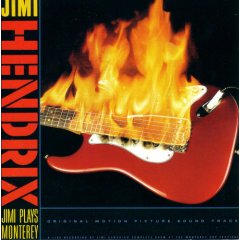
Jimi Plays Monterey is a posthumous live album by Jimi Hendrix released in February 1986. The album documents The Jimi Hendrix Experience's performance at the Monterey Pop Festival on June 18, 1967. As well as songs from the band's debut album Are You Experienced, Monterey also includes covers of "Killing Floor", "Like a Rolling Stone", "Rock Me Baby" and "Wild Thing". The version of "Wild Thing" on the album is one of the most notable live performances ever, as, in an iconic moment in rock history, Jimi sets his guitar alight after the song and then smashes it.

Victor Harvey Briggs III was a British blues and rock musician, best known as the lead guitarist with Eric Burdon and The Animals during the 1966–1968 period. Briggs, a convert to Sikhism, later played classical Indian and Hawaiian music, and adopted the name Antion Vikram Singh Meredith.

Historic Performances Recorded at the Monterey International Pop Festival is a live album recorded at the Monterey Pop Festival in June 1967. A split artist release, it documents performances by the Jimi Hendrix Experience on side one and Otis Redding on side two.
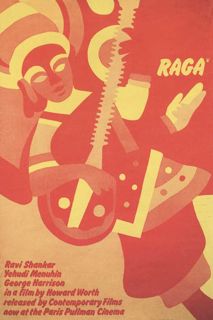
Raga is a 1971 documentary film about the life and music of Indian sitarist Ravi Shankar, produced and directed by Howard Worth. It includes scenes featuring Western musicians Yehudi Menuhin and George Harrison, as well as footage of Shankar returning to Maihar in central India, where as a young man he trained under the mentorship of Allauddin Khan. The film also features a portion of Shankar and tabla player Alla Rakha's acclaimed performance at the 1967 Monterey Pop Festival.
Wally Heider (1923–1989) was an American recording engineer and recording studio owner After a career as an engineer in the 1940s and 1950s, he was instrumental in recording the San Francisco Sound in the late 1960s and early 1970s. Many of Rolling Stone magazine's Top 500 albums were recorded in his studio including Volunteers by Jefferson Airplane, Everybody Knows This Is Nowhere by Neil Young with Crazy Horse, Déjà Vu by Crosby, Stills, Nash & Young, Electric Warrior by T. Rex, Tupelo Honey by Van Morrison, American Beauty by the Grateful Dead, Green River by Creedence Clearwater Revival, Amazing Grace by Aretha Franklin and Abraxas by Santana.
"Monterey" is a 1967 song by Eric Burdon & The Animals. The music and lyrics were composed by the group's members, Eric Burdon, John Weider, Vic Briggs, Danny McCulloch, and Barry Jenkins. The song provides an oral account of the June 1967 Monterey Pop Festival, at which the Animals performed. Burdon namedrops several of the acts who performed at the festival such as the Byrds, Jefferson Airplane, the Who, the Grateful Dead, and Jimi Hendrix. In 1968, two different video clips of the song were aired.
This is a list of the performers at the Monterey Pop Festival, held June 16 to June 18, 1967 at the Monterey County Fairgrounds in Monterey, California.

The Toronto Rock and Roll Revival was a one-day, twelve-hour music festival held in Toronto, Ontario, Canada on September 13, 1969. It featured a number of popular musical acts from the 1950s and 1960s. The festival is particularly notable as featuring an appearance by John Lennon and Yoko Ono, as the Plastic Ono Band, which resulted in the release of their Live Peace in Toronto 1969 album. The festival was also the subject of the D.A. Pennebaker film, Sweet Toronto.

Keep on Rockin', aka Little Richard: Keep on Rockin is a film of a 1969 Little Richard concert at the Toronto Rock and Roll Revival festival originally released in 1970. The film is in colour.

Lei'd in Hawaii is an unfinished live album by American rock band the Beach Boys that was produced shortly after the completion of their 1967 studio album Smiley Smile. It was initially planned to include the band's first live concert performances since their tour of Europe in May. The two concerts, held at the Honolulu International Center Arena on August 25 and 26, featured a rare appearance from Brian Wilson, marking his only shows with the touring group between 1965 and 1970. It was also the band's first public appearance following their controversial withdrawal from the Monterey Pop Festival that summer.

Live: Ravi Shankar at the Monterey International Pop Festival is a live album by Indian sitarist Ravi Shankar, released on the World Pacific record label in November 1967. It consists of part of Shankar's celebrated performance at the Monterey International Pop Festival in California on 18 June 1967. Shankar was accompanied throughout by his regular tabla player, Alla Rakha, who performs a frenetic five-minute solo on the recording.
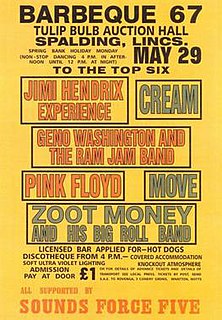
Barbeque 67 was a music event held in the market town of Spalding, Lincolnshire, East Midlands of England, United Kingdom. Despite the presence of many well-known artists among its lineup, the event remains largely unknown. It is considered by some to have been the first rock festival.

In May 1968, the American rock band the Beach Boys undertook a concert tour of the United States with Maharishi Mahesh Yogi, their Indian meditation guru. The tour preceded the release of the Beach Boys' Friends album, which similarly reflected the influence of the Maharishi's Transcendental Meditation (TM) technique on the band, and was a commercial and critical failure. The program comprised a set of songs by the Beach Boys, followed by a lecture from the Maharishi on the benefits of meditation. Twenty-nine concerts were originally scheduled, many of them in college venues, but the venture was abandoned after three days of low ticket sales and hostile audience reaction to the Maharishi's segment. The guru's commitment to making a documentary film about himself, for Four Star Television, was cited as a further impediment.



















